Key Insights
- Ethereum Name Service (ENS) allows users to interact with wallets via human-readable domain names.
- After reaching an all-time high in Q3’22, ENS domain registrations dropped 73% QoQ. Simultaneously, ENS domain renewals decreased 17% QoQ from the peak of Q3’22.
- On a YoY basis, both registrations and renewals increased 31% and 295%, respectively.
- The ownership of ENS domains is driven by domain names registered by addresses that have already registered other names in the past.
- Total revenue from registrations and renewals decreased 63% QoQ in USD terms (down 60% in ETH). YoY, total revenue decreased 60% in USD terms (up 30% in ETH).
Primer on ENS
Handling blockchain addresses is error-prone. Blockchain addresses consist of a series of alphanumeric characters such as “Ox57f1…”, which is anything but intuitive for humans.
The Ethereum Name Service (ENS) allows users to interact with blockchain addresses via human-readable domain names. ENS offers a user-friendly solution that maps blockchain addresses to domain names that are easy to reproduce.
In contrast to a normal Web domain, an ENS domain name:
- can be used as a payment gateway — for example, one can send money to sassal.eth instead of typing out or copy-pasting Sassal’s hexadecimal address.
- cannot be ceased and their content cannot be deleted.
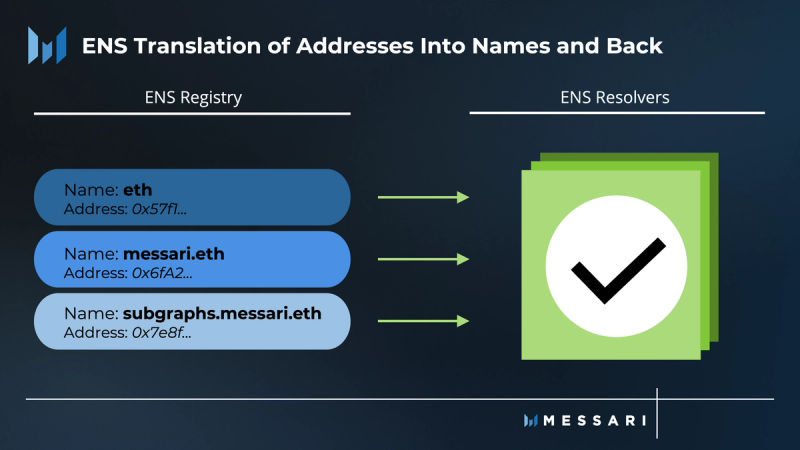
At its core, ENS operates on a system of hierarchical names. A top-level registry deployed as a contract on-chain keeps a record of each ENS domain name (e.g., messari.eth) and subdomains (e.g., subgraphs.messari.eth). The ENS registry controls domains and governs the distribution of subdomains.
The translation from ENS domain names (e.g., messari.eth) to the corresponding blockchain addresses (e.g., “0x6fA2… ”) and vice versa is done by smart contracts called ENS resolvers.
Key Metrics
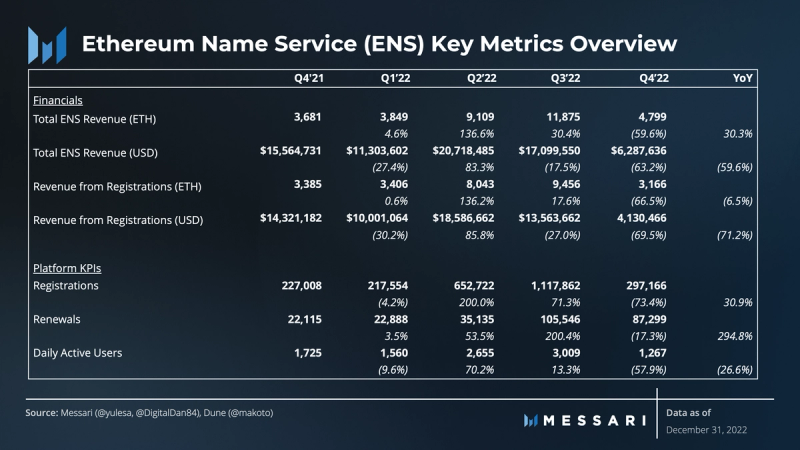
Performance Analysis
ENS quarterly performance can be gauged in terms of ENS domain name usage and in terms of revenue accrued from domain name registrations and renewals.
Usage
ENS domains can be registered and owned on a multi-yearly basis, and the number of years is chosen by the user – the minimum is one year. Price and registration period share a positive relationship: price increases as the period of registration increases.
To retain the domain ownership, users must renew within 90 days of expiry. Domains unrenewed after a 90-day renewal period are available for registration.
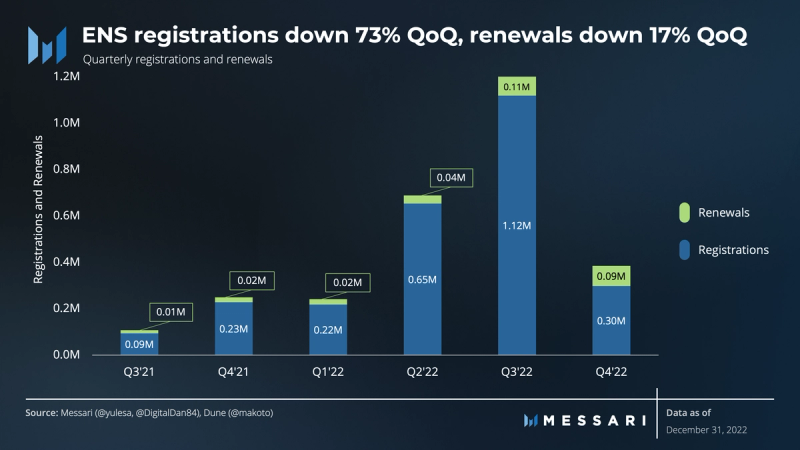
After reaching an all-time high in Q3’22, ENS domain name registrations decreased 73% QoQ from over 1.1 million in Q3’22 to almost 300,000 in Q4’22. Simultaneously, ENS domain name renewals decreased 17% QoQ from an all-time high of 106,000 in Q3’22 to 87,000 in Q4’22.
Registration Activity
The 73% QoQ drop in registrations may be further explained in the context of ENS daily active users (DAU). To be considered active, a user must do at least one of the following:
- Have a domain name registered or renewed.
- Commit on-chain transactions.
- Add metadata (such as avatars, handles, links, or email addresses).
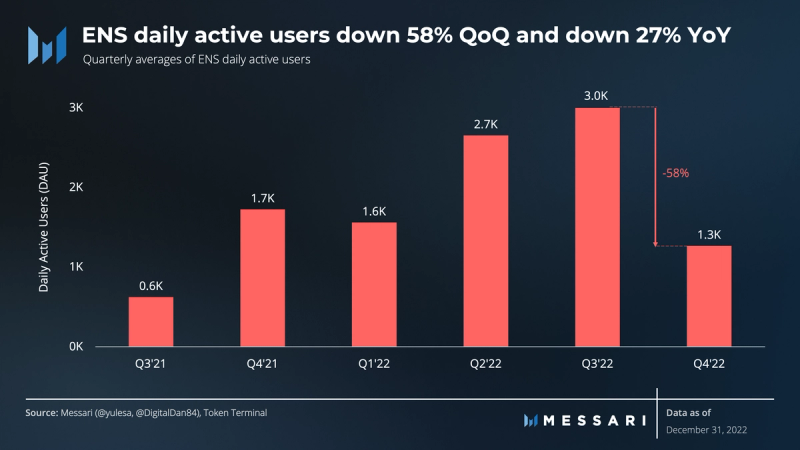
Q4’22 experienced a 68% drop in DAUs, in line with the 73% QoQ registration drop. Notably, in Q4’22, DAUs decreased below last year’s level, down 27% YoY. The extent to which this drop corresponds with specific dynamics in domain ownership behavior is determined by the distinction between:
- First-time domain owners — i.e., domain names registered by an address that has never registered a domain name before, versus
- Returning domain owners — i.e., domain names registered by an address that has already registered another name.
To exemplify the contrast between first-time and returning domain owners in practice, let’s assume a domain owner registered three different domain names in the following chronological order: domain1.eth, domain2.eth, and domain3.eth. The first one (domain1.eth) would count as a new domain owner, whereas the next two (domain2.eth and domain3.eth) would each count as returning domain owners. The distribution of first-time and returning domain owners is shown below.
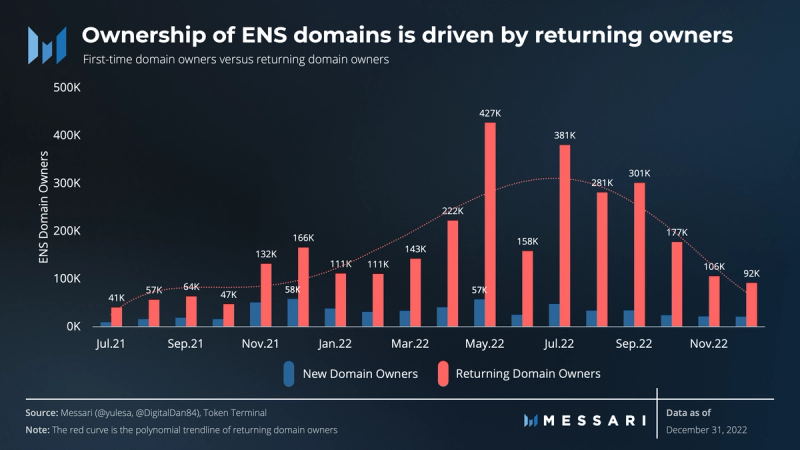
The ownership of ENS domains is driven by returning domain owners. For instance, May 2022 saw a total of 484,000 registered ENS domains as follows: 427,000 were returning domain owners, and 57,000 were first-time domain owners.
While first-time domain owners represent a relatively small proportion of domain registrations. The slowdown in ENS domain name usage may be explained by the potential difficulty in attracting first-time owners for ENS domains. In addition, ENS appears to follow more of a subscription model rather than a pay-per-tx model (e.g., of exchanges such as Uniswap or of marketplaces such as OpenSea). Given that returning domain owners users are driving ENS ownership, ENS names are likely being perceived as valuable over their subscription lifetime.
Renewal Activity
The 17% QoQ drop in renewals needs to be further explained in the context of expected domain expirations in Q4’22.
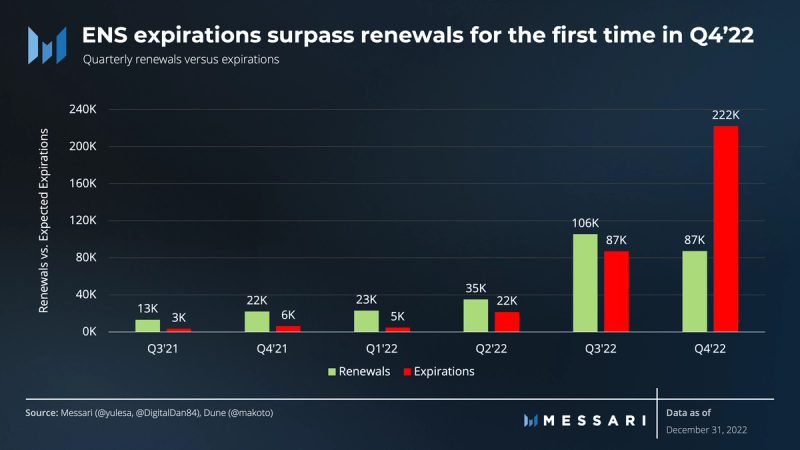
Q4’22 was the first quarter that ENS domain expirations surpassed ENS domain renewals. The expected expirations in Q4’22 were more than 2.5 the size of the actual renewals. Approximately 84% (186,000) of the 222,000 expected expirations in Q4’22 were domain names registered for one year. This is in line with the corresponding figures in Q3’22: 83% of the 87,000 expected expirations in Q3’22 were domain names registered for one year. That is, most of the expirations were domain names that were registered speculatively for the shortest possible period of time (i.e., one year) during the boom in Q3/Q4’22.
However, not all ENS domain names are created and used equally. A notable difference is the domain name length. Within the landscape of name lengths, different combinations of characters have different rarities. Shorter domain names (3-5 characters) appear less frequently than medium-length names (6-10 characters). There are essentially infinitely many long domain names (11+ characters).
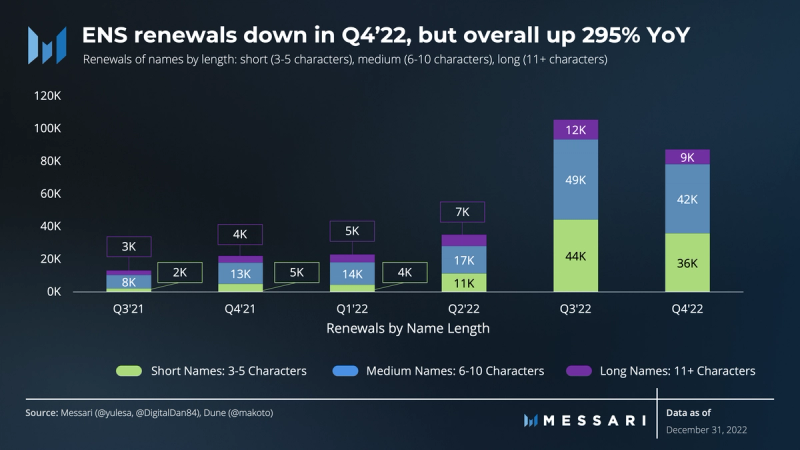
The distribution of renewals relative to name length reveals how ENS holders perceive their ENS domain names. While there is a 17% QoQ drop in renewals in Q4’22, the overall renewals increased 295% YoY. Notably, renewals of short names grew more than 7x YoY.
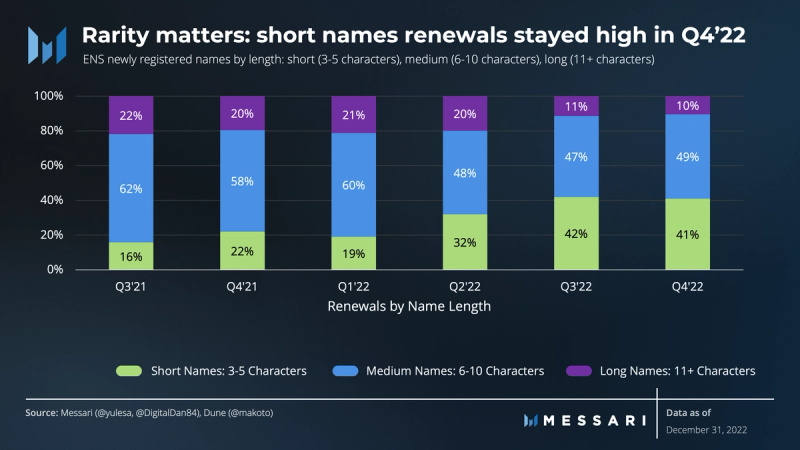
When it comes to the relative percentage of ENS renewals, short names maintained their share above 40% of total renewals. This may imply that ENS holders continue to value their shorter ENS domain names enough to hold in the longer term despite their higher renewal prices.
Revenue
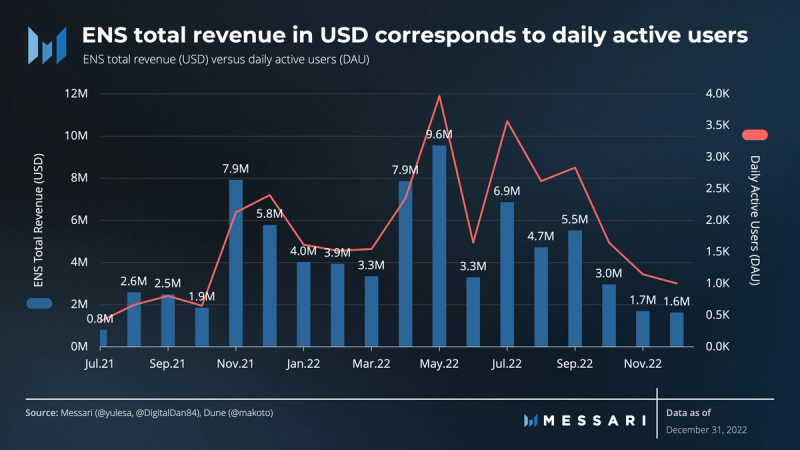
ENS total revenue is a function of the ENS domain name usage: peaks in user activity tend to correspond to more revenue being generated. ENS accrues revenue by charging two distinct fees: registration fees and renewal fees.

In Q4’22, the overall revenue from both domain name registrations and renewals dropped 63% QoQ in USD terms (down 60% QoQ in ETH terms). This decrease was driven by a 70% QoQ decrease in registration revenue in USD terms from $13.6 million in Q3’22 to $4.1 million in Q4’22 (down 71% YoY). In ETH terms, registrations fell 67% QoQ and 7% YoY.
Simultaneously, revenue from renewals decreased 39% in USD terms from $3.5 million in Q3’22 to $2.2 million in Q4’22. In ETH terms, renewal revenue decreased 32% QoQ but increased by a whopping 452% YoY, partly due to the overall increase in total registrations. A further way to understand the revenue drivers is to cluster ENS total revenue by name length.

Over the past six quarters, ENS domain renewals of short names accounted for well above 50% of the total ENS revenue. It’s worth noting that registering and renewing short ENS names cost substantially more than registering longer names. For instance, registering a 3 character .eth name costs $640 in ETH per year on average, registering a 4 character .eth name costs $160 in ETH per year on average, whereas the registration of names above 5 characters costs $5 in ETH per year on average. This price differential reflects the total existing name combinations: shorter character names are less in number than longer names.
Qualitative Analysis
Governance
ENS is operated by a DAO that is governed by the holders of the native ERC-20 token — ENS. Tokenholders are able to submit and vote on proposals.
An early proposal to transfer ownership of treasury funds from multisig.ens.eth to the DAO contract at wallet.ensdao.eth. It resulted in ENS tokenholders being transferred governance rights over the protocol treasury.
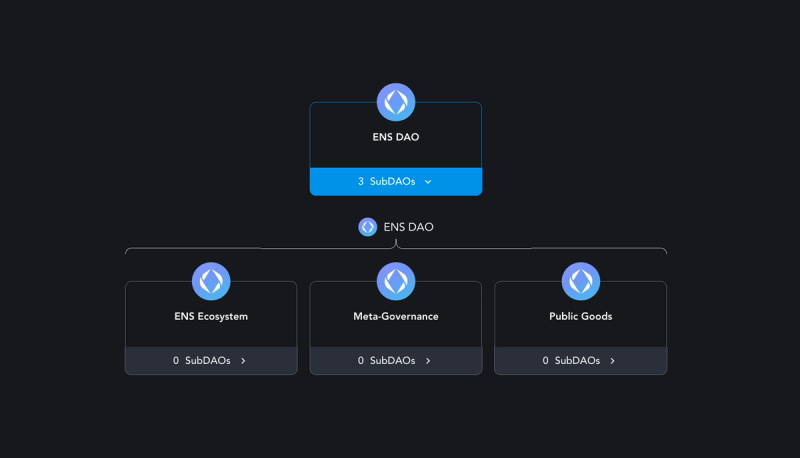
Source: Messari Governor
There are three working groups within the ENS DAO: meta-governance, ecosystem, and public goods. The Q3/Q4 budget overview describes the budget for each group as follows:
- Meta-Governance: $632,000, with an allocation of $200,000 to support ENS DAO tooling, oversee governance partnerships, and gas-fee reimbursement.
- Ecosystem: $2,254,300, with the largest allocation of $1.5 million to support members and matters associated with the domain service: bug bounties, hackathons, Gitcoin grants, and more.
- Public Goods: $430,650, with $173,000 allocated to the ENS DAO small grants program. Overall, this working group aims to support ENS projects within the wider Web3 ecosystem.
Treasury
The ENS treasury holds approximately $163 million in unlocked funds and an additional claim to approximately $220 million representing the equivalent of 14.2 million locked ENS tokens out of the total 61.2 million ENS tokens locked in the vesting contract.
EP 2.2.5: ENS Endowment Fund Manager: The DAO submitted a Request For Proposal to find a fund manager to manage the treasury. The follow-up proposal finished with 57.62% of the votes in favor of selecting Karpatkey as the fund manager of the ENS endowment. The endowment aims to ensure that ENS can meet its ongoing financial obligations despite the reduced ETH price and the declines in registration/renewal revenue in USD.
Key Events
In Q4’22, each of the three working groups within the ENS DAO elected their stewards for Q1/Q2 2023:
ENS Meta-Governance Steward Election: Q1/Q2 2023: The DAO elected three stewards for the Meta-Governance Working Group for the First Term of 2023 (Q1/Q2): nick.eth, simona.eth, and Katherine Wu.
ENS Ecosystem Steward Election: Q1/Q2 2023: The DAO elected three stewards for the ENS Meta-Governance Working Group for the First Term of 2023 (Q1/Q2): slobo.eth, limes.eth, and yambo.eth.
ENS Public Goods Steward Election: Q1/Q2 2023: The DAO elected three stewards for the ENS Public Goods Working Group for the First Term of 2023 (Q1/Q2): avsa.eth, coltron.eth, and vegayp.eth.
A full list of ENS events can be found on Messari’s Intel and Governor pages.
Closing Summary
In terms of user experience, ENS made a significant step forward for the entire Web3 space. ENS offers a user-friendly solution that maps blockchain addresses to domain names that are easy to reproduce. Anyone can register and own ENS domains on a multi-yearly basis.
After reaching an all-time high in Q3’22, ENS domain name registrations decreased 73% QoQ. The ownership of ENS domains is driven by domain names registered by addresses that have already registered other names in the past. This suggests that the slowdown in ENS domain name usage may be explained by an increased difficulty in attracting first-time owners for ENS domains. Simultaneously, ENS domain name renewals decreased 17% QoQ from its all-time high in Q3’22. On a YoY basis, both registrations and renewals increased 31% and 295%, respectively.
ENS total revenue is a function of the ENS domain name usage: peaks in user activity tend to correspond to more revenue being generated. Revenue from registrations and renewals decreased 63% QoQ in USD terms (down 60% in ETH). YoY, revenue from registrations and renewals decreased 60% in USD terms (up 30% in ETH).
While it is an unarguably unique and solid project, the real test for ENS is building a sustainable base of users around solid use cases.
















